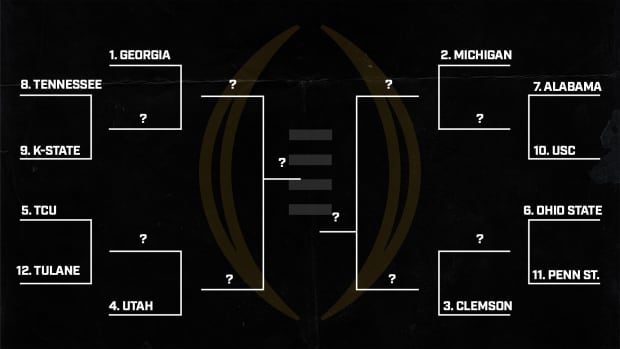After this year, there is only one more season with the College Football Playoff as we know it. Starting with the 2024 season, the Playoff will expand from a four-team field to a 12-team field. That will bring plenty of change to college football’s postseason and open up the national title race to a host of new programs.
In the CFP era, which began in 2014, only 14 schools have made the nine editions of the Playoff. Alabama (seven appearances), Clemson (six) and Ohio State (five) have claimed half of the 36 slots that have existed, and just seven schools have been to the Playoff more than once.
But what if the 12-team model had been in effect all along? Don’t forget, the future format has rules: (1) the six highest-ranked conference champions get automatic berths; (2) the next six highest-ranked teams get at-large spots; (3) byes go to the top four conference champs; and (4) first-round games are played at the better seed’s home stadium (quarterfinals and semifinals are played in a rotation of six bowls).
Here’s what all nine past Playoff brackets (including 2022) would have looked like with 12 teams.
An asterisk(*) means the team receives a first-round bye.
2014 CFP
How it would’ve gone:
No. 1 Alabama*
No. 2 Oregon*
No. 3 Florida State*
No. 4 Ohio State*
No. 5 Baylor hosts No. 12 Boise State
No. 6 TCU hosts No. 11 Kansas State
No. 7 Mississippi State hosts No. 10 Arizona
No. 8 Michigan State hosts No. 9 Ole Miss
Note: In 2014, Baylor and TCU were co–Big 12 champions. For this exercise, we considered the team that finished higher in the CFP rankings—Baylor—as the one that earned the automatic berth.
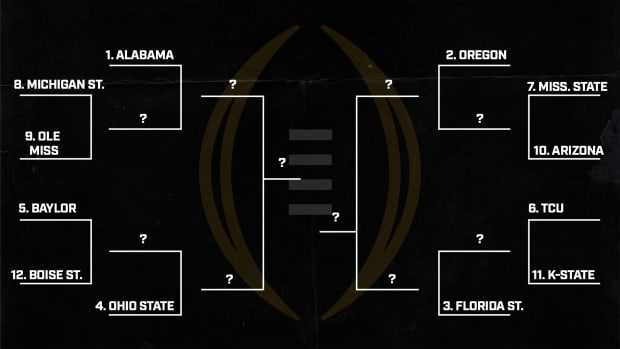
How it really went: No. 4 Ohio State beat No. 1 Alabama; No. 2 Oregon beat No. 3 Florida State. Ohio State beat Oregon for the national championship.
What it means: The 12-team model would’ve carried the same top-four seeds, but this CFP was known for chaos, with the No. 4 Buckeyes winning it all. Perhaps an expanded field would have seen further upsets—or perhaps not. The SEC and Big 12 would’ve combined for half of the expanded field in its debut year, with three teams apiece.
2015 CFP
How it would’ve gone:
No. 1 Clemson*
No. 2 Alabama*
No. 3 Michigan State*
No. 4 Oklahoma*
No. 5 Iowa hosts No. 12 Houston
No. 6 Stanford hosts No. 11 TCU
No. 7 Ohio State hosts No. 10 North Carolina
No. 8 Notre Dame hosts No. 9 Florida State
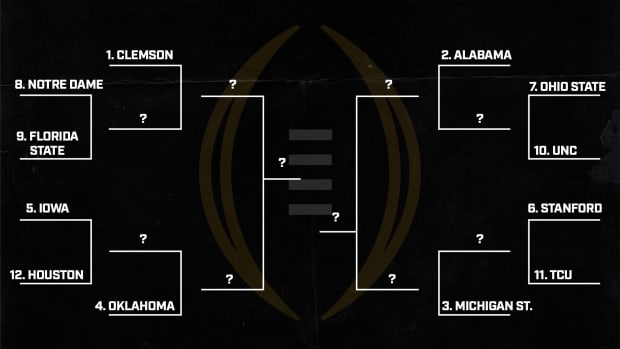
How it really went: No. 1 Clemson beat No. 4 Oklahoma; No. 2 Alabama beat No. 3 Michigan State. Alabama beat Clemson for the national championship.
What it means: Again, there would’ve been no change among the top four. Interestingly, even with 12 teams, there would’ve still been only one from the SEC. That’s surprising considering how well the conference has been represented in the four-team format. The Big Ten, however, would’ve had one-quarter of the 12 seeds.
2016 CFP
How it would’ve gone:
No. 1 Alabama*
No. 2 Clemson*
No. 3 Washington*
No. 4 Penn State*
No. 5 Ohio State hosts No. 12 Western Michigan
No. 6 Michigan hosts No. 11 Florida State
No. 7 Oklahoma hosts No. 10 Colorado
No. 8 Wisconsin hosts No. 9 USC
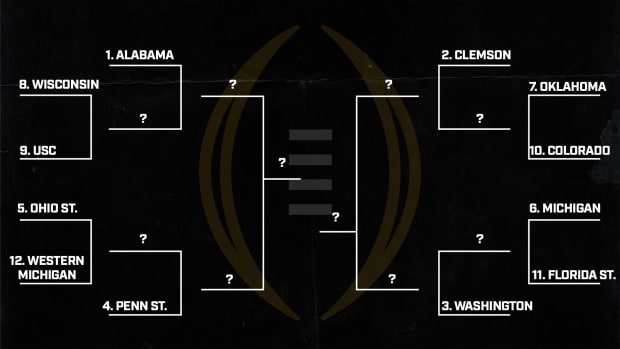
How it really went: No. 1 Alabama beat No. 4 Washington; No. 2 Clemson beat No. 3 Ohio State. Clemson beat Alabama for the national championship.
What it means: This is the first year where the 12-team model would’ve produced a change in the top four. Penn State beat Ohio State for the Big Ten championship and was among the highest four ranked conference winners, meaning the Nittany Lions receive a first-round bye in the expanded bracket, even though the Buckeyes ranked two spots higher in the final CFP ranking. The Big Ten would’ve had a whopping half of the top-six seeds in this model, while the Pac-12 would’ve had three of the 12 compared to the SEC’s one.
2017 CFP
How it would’ve gone:
No. 1 Clemson*
No. 2 Oklahoma*
No. 3 Georgia*
No. 4 Ohio State*
No. 5 Alabama hosts No. 12 UCF
No. 6 Wisconsin hosts No. 11 Washington
No. 7 Auburn hosts No. 10 Miami
No. 8 USC hosts No. 9 Penn State
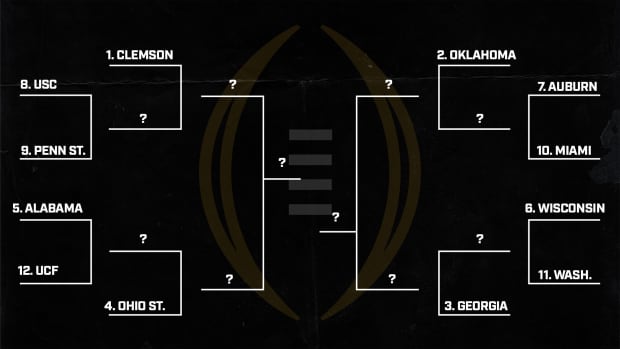
How it really went: No. 4 Alabama beat No. 1 Clemson; No. 3 Georgia beat No. 2 Oklahoma. Alabama beat Georgia for the national championship.
What it means: This is the first time each team within the top 12 of the final CFP ranking would’ve also made the 12-team field. That’s because each of the six-highest ranked conference champions were among the top 12. But Alabama would’ve fallen out of the top four, dropping one spot to No. 5 by virtue of not winning the SEC title. Would the Tide have still won the whole thing? It would’ve been fun to see Alabama and national-championship-claiming UCF settle things on the field (in the first round, no less), but we’re not betting against Nick Saban.
2018 CFP
How it would’ve gone:
No. 1 Alabama*
No. 2 Clemson*
No. 3 Oklahoma*
No. 4 Ohio State*
No. 5 Notre Dame hosts No. 12 Penn State
No. 6 Georgia hosts No. 11 LSU
No. 7 Michigan hosts No. 10 Florida
No. 8 UCF hosts No. 9 Washington
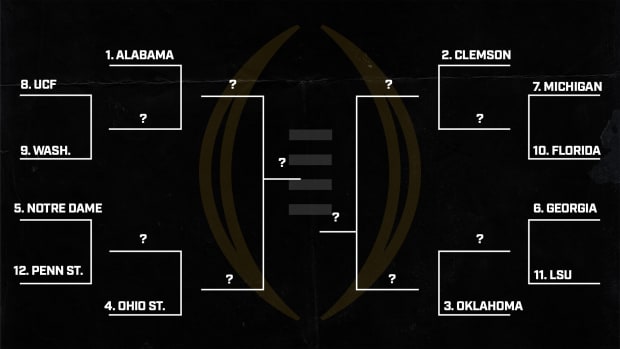
How it really went: No. 1 Alabama beat No. 4 Oklahoma; No. 2 Clemson beat No. 3 Notre Dame. Clemson beat Alabama for the national championship.
What it means: The Notre Dame conundrum strikes for the first time! As an independent, the Irish are locked out of landing among the top-four seeds under the 12-team model since they can’t win a conference title. So they go from the No. 3 seed in real life to the No. 5 seed here. But the next team up, Georgia, also didn’t win its conference. That means actual No. 6 seed Ohio State would’ve nabbed a top-four spot in this model, while Georgia would’ve dropped one to the sixth seed. Shout-out to UCF, which would’ve become the first Group of 5 program to host a Playoff game.
2019 CFP
How it would’ve gone:
No. 1 LSU*
No. 2 Ohio State*
No. 3 Clemson*
No. 4 Oklahoma*
No. 5 Georgia hosts No. 12 Memphis
No. 6 Oregon hosts No. 11 Utah
No. 7 Baylor hosts No. 10 Penn State
No. 8 Wisconsin hosts No. 9 Florida
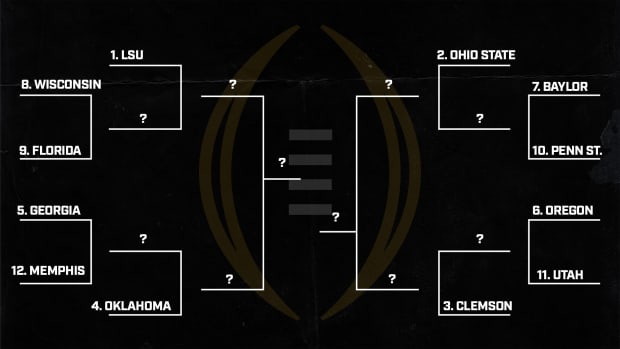
How it really went: No. 1 LSU beat No. 4 Oklahoma; No. 3 Clemson beat No. 2 Ohio State. LSU beat Clemson for the national championship.
What it means: There’s no change among the top four in this 12-team model, and anyone would’ve been hard-pressed to topple that Joe Burrow–led juggernaut LSU team. This would’ve been Memphis’s first Playoff berth.
2020 CFP
How it would’ve gone:
No. 1 Alabama*
No. 2 Clemson*
No. 3 Ohio State*
No. 4 Oklahoma*
No. 5 Notre Dame hosts No. 12 Coastal Carolina
No. 6 Texas A&M hosts No. 11 Indiana
No. 7 Florida hosts No. 10 Iowa State
No. 8 Cincinnati hosts No. 9 Georgia

How it really went: No. 1 Alabama beat No. 4 Notre Dame; No. 3 Ohio State beat No. 2 Clemson. Alabama beat Ohio State for the national championship.
What it means: This was the season most impacted by COVID-19, which resulted in uneven schedules and games played. It would’ve created quite an unorthodox 12-team Playoff. First-timers Texas A&M, Cincinnati, Iowa State and Coastal Carolina would have been in the field, with the Bearcats and Chanticleers marking the first time there were two Group of 5 programs in the same bracket. That’s because both AAC champ Cincinnati (No. 8) and Sun Belt champ Coastal (No. 12) finished higher than Pac-12 champ Oregon, which played only six games and was 25th in the final CFP ranking.
Watch college football live with fuboTV: Start a free trial today.
2021 CFP
How it would’ve gone:
No. 1 Alabama*
No. 2 Michigan*
No. 3 Cincinnati*
No. 4 Baylor*
No. 5 Georgia hosts No. 12 Pittsburgh
No. 6 Notre Dame hosts No. 11 Utah
No. 7 Ohio State hosts No. 10 Michigan State
No. 8 Ole Miss hosts No. 9 Oklahoma State

How it really went: No. 1 Alabama beat No. 4 Cincinnati; No. 3 Georgia beat No. 2 Michigan. Georgia beat Alabama for the national championship.
What it means: More change and more first-timers! Welcome, Oklahoma State and Pittsburgh to their first Playoff. Gone is Georgia’s real-life No. 3 seed—after losing the SEC title game, it drops to fifth. Notre Dame and Ohio State can’t take that top-four slot, either, so it goes to Baylor, which was No. 7 in the final CFP rankings. Cincinnati still makes history as the first Group of 5 program to get a first-round bye, and this time is on the opposite side of the bracket from Alabama.
2022 CFP
How it would’ve gone:
No. 1 Georgia*
No. 2 Michigan*
No. 3 Clemson*
No. 4 Utah*
No. 5 TCU hosts No. 12 Tulane
No. 6 Ohio State hosts No. 11 Penn State
No. 7 Alabama hosts No. 10 USC
No. 8 Tennessee hosts No. 9 Kansas State
